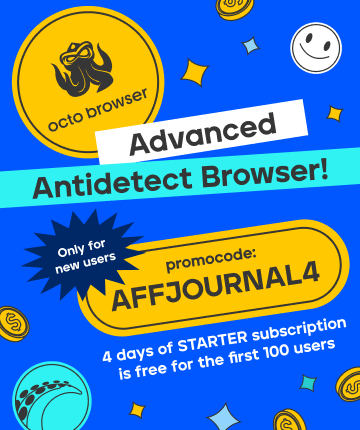

by Editor
Many webmasters choose offers based on their subjective judgments or just at random. Considering that in affiliate marketing a webmaster constantly risks his money, it is desirable to minimize the effect of the lottery at every step in preparation for the bay. Today we’ll figure out what to look for when choosing an offer in the CPA network and what will affect its conversion rate.
10 rules: what to look for when choosing an offer
The following are some fairly general guidelines. But even they will already correct your choice in the right direction. If you already know all of them, then be sure to read the section on testing the offer. We hope that you will find some insights for yourself there.
Rule #1: Multi GEO offer is better than one GEO offer
If you take an offer with one GEO, then the CPM (cost per thousand impressions) will be too high. Also, a narrow GEO can usually cause a low approval. Everything is simple. Facebook will give preference to the audience that showed the most interest in the first time after the launch of the advertising campaign. Thus, from 60% of the traffic will be given to the converting audience, even if the number of leads there is minimal.
Rule #2: Don't take an offer with a narrow audience
This can lead to a lack of sales and a merged advertising campaign. You can also narrow the audience yourself, but you don’t need to do this. Facebook pre-rolls multiple audiences on its own and selects the one that suits you best. As a result, the CPM will be lower and the audience will be picked up faster.
Rule #3: Do not take offers from the TOP affiliate program
Do not use offers from the TOP, they are most likely already occupied by large media buying teams. If you decide to drive to TOP offers, then be prepared for the fact that most of the leads will go to trash, and the approval will be too low (if we are talking about nutra or e-commerce).
Rule #4: Communicate with managers
Communicate with managers and find out the average approval for specific GEOs and offers, so as not to make a mistake in choosing.
Rule #5: Know Your Target Audience
Choose offers whose audience you really understand, otherwise there is a risk of draining the entire advertising budget.
Rule #6: Take an offer with a simple target action
Look at the complexity of the target action. Usually, the more difficult the action, the higher the payment. However, if you have small budgets, then you should not pay attention to overly complex CPA offers.
Rule #7: Use Analytics Services
Use Google Trends to analyze the popularity of an offer. Choose only those offers that are at the highest point of their popularity or are just starting to grow.
Rule #8: Make sure your offer has a unique USP
Pay attention to the uniqueness of the offer. If he does not have a clearly formulated USP, then the user is unlikely to want to follow your link. Discounts, registration bonuses, etc. will positively affect the approval.
Rule #9: Landing Page Price Must Be Affordable to Your Target Audience
Choose offers with an acceptable price on the landing page for a specific GEO. Not too expensive, not too cheap - look for the middle ground.
Rule #10: Take only the best
Feel free to ask CPA network managers about the most converting landing pages.
How to test an offer CORRECTLY
Unfortunately, in order to qualitatively test the offer and say for sure that it does not convert, you will have to develop a whole bunch for it. That is, if you took 3-4 offers for a split test, you will have to work hard. Nevertheless, let's try to minimize labor, time and money costs.
The bundle includes many variables: GEO, offer, landing page, applications (if you are running for gambling), targeting, placement (now we are talking about Facebook) and creatives. Let's exclude everything that does not depend on us:
-
GEO. The manager must ask in which traffic source the ad will be launched and provide information / analytics on the offer in this GEO. If he cannot provide this information, then we go to the SPY service and look for campaigns according to our GEO. If there are few of them, the competition is weak, so you can try.
-
Placements. If we are talking about Facebook Ads, then these are 2 sets of placements - auto and Facebook feed.
-
Landing. We look at options and statistics on them from the manager, we prefer wheels of fortune, boxes and other gamification.
Rest:
-
Targeting. You can test restrictions on regions, cities, thereby highlighting the desired audience.
-
Accommodation. If we are talking about Facebook Ads, then these are 2 sets of placements - auto and Facebook feed (well, or your own developments).
-
Creatives. Do it yourself, order. There are many DIY guides for creatives on our site. Well, according to the gold standard, we make at least 3 different creatives.
In total, we get: 2 goal options, 2 placement sets, 3 creatives. Total links for the test - 12. For each targeting we have 2 sets of placements and for each placement - a creative.
As has been discussed a thousand times already, in order to qualitatively test each bundle, you need to shed up to two conversion costs. That is, multiply 12 by the amount of payment for the offer - we get the budget for tests. If the payment is $30, then the tests need about $540.
IMPORTANT! Naturally, this does not mean that you need to take, immediately create 12 companies and drain $ 540 on Facebook. It is better to test each theory in turn. You may be lucky and get a converting bundle already, for example, on the third launch. Then the remaining budget can be spent on scaling.
...Or maybe not, but you will receive invaluable information for further analytics. Good luck!

by Editor



comments ....(0)
Leave a comment
You must be in to leave a comment